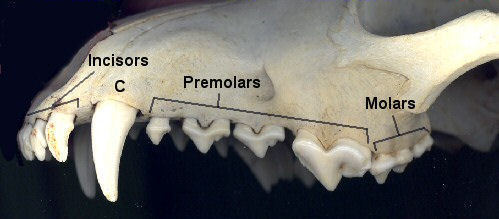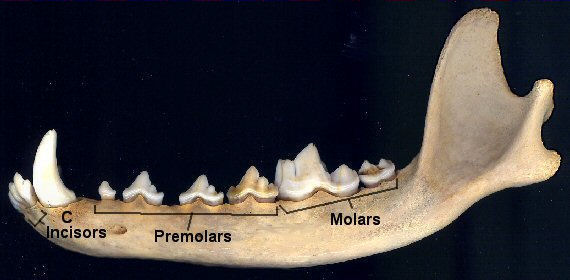
Teeth that are lost evolutionarily usually are lost at the ends of the functional rows: Thus commonly incisors are lost from the outer parts (first I3, then I2, etc.), premolars from the front (P1, then P2, etc.), and molars from the back (M3, then M2, then M1). As an example, our human tooth formula is 2/2, 1/1, 2/2, 3/3 = 16 X 2 = 32; we have lost I3, and P1, P2. The remaining premolars (the "bicuspids" of dentists) are P3 and P4 for the uppers and p3 and p4 for the lowers. When tooth types are lost entirely, as in many mice and rats, the absent ones generally are indicated by zeros. Thus the tooth formula for a house mouse is 1/1 0/0 0/0 3/3 (that is, they have no canines and no premolars). Often, but not always, there is a space left where a tooth type has been lost; such a space is a diastema. For example, there is a long diastema between the incisors and the cheekteeth in the house mouse (and, in fact, in all rodents).
In most cases, the morphology of each type of tooth is unique, though somewhat variable within the group. Most likely to be confused are premolars and molars. Premolars usually are simpler and generally are two-rooted whereas molars generally have more than two roots. In some mammals, one or more of the premolars take on the function and appearance of molars—a condition called molarization. Horses are an extreme case, where P2-M3 form a dental battery with the premolars almost identical to the molars.
Even in the horses, however, there is one major difference. Mammals are diphyodont—that is, they have two generations of teeth, whereas in other tetrapods, teeth normally are replaced an indefinite number of times. In placentals, only the incisors, canines, and premolars are replaced. The first generation consists of deciduous teeth (lacteal teeth, milk teeth, baby teeth) and eventually are replaced by permanent teeth. In marsupials, only the third premolar is replaced. Deciduous teeth when abbreviated are preceded by "D" (upper) or "d" (lower); thus the last lower, deciduous premolar in a placental is designated as dp4.

Upper dentition of a dog. Canines have 3 incisors, 1 canine, 4 premolars, and 2 molars on each side of the upper jaws. In the Carnivora, the 4th upper premolar is the upper carnassial that, together with the lower 1st molar forms the carnassial pair, considered a characteristic of the Carnivora.

Lower dentition of a dog. Most canines have 3 incisors, 1 canine, 4 premolars, and 3 molars on each of the lower jaws. This particular specimen is missing the 3rd molar.
